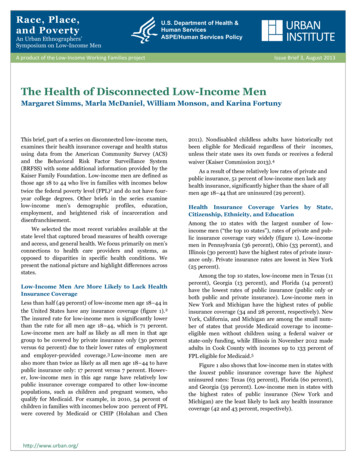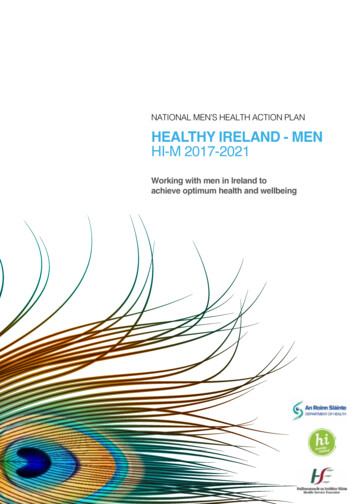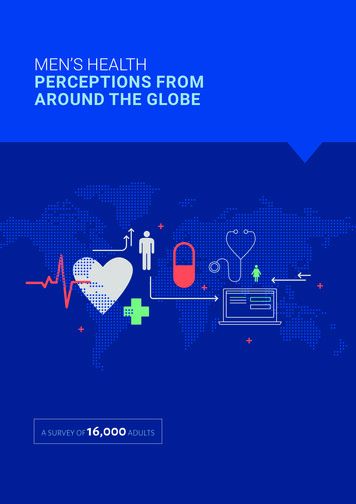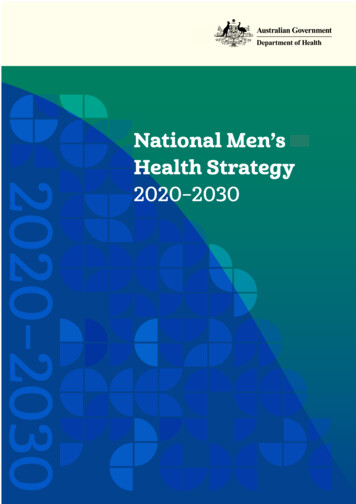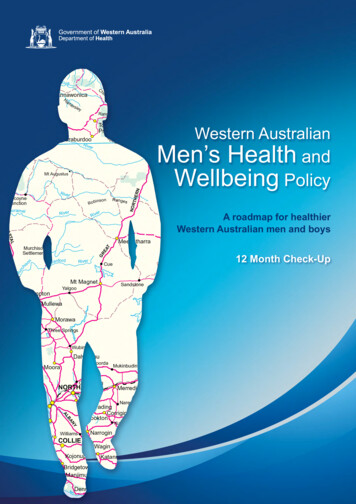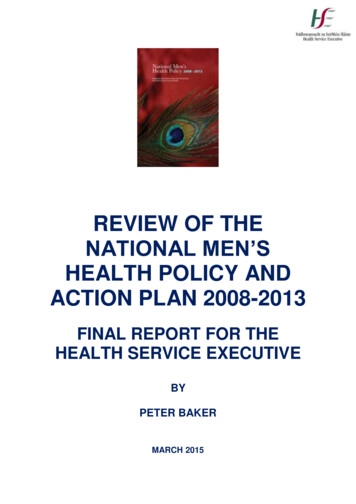
Transcription
REVIEW OF THENATIONAL MEN’SHEALTH POLICY ANDACTION PLAN 2008-2013FINAL REPORT FOR THEHEALTH SERVICE EXECUTIVEBYPETER BAKERMARCH 2015
CONTENTSAcknowledgementsp3Abbreviationsp4Executive Summaryp5Backgroundp9Purpose of the Reviewp9Methodologyp10Findings1. The state of men’s health in Ireland2. The role of policy in improving men’s health3. The impact of men’s health policy in other countries4. The impact of men’s health policy in Ireland5. Men’s health policy on the context of Healthy Ireland6. Conclusionp12p15p20p24p57p62Appendices1. The Review team2. The national and international literature review3. In-depth one-to-one interviews conducted with key stakeholders4. The online survey5. The survey of key National Men’s Health Policy and Action Planimplementation stakeholdersp63p64p65p67p68Referencesp69Page 2 of 71
ACKNOWLEDGEMENTSA large number of people – too many to name all of them here – gave generously of theirtime, insight and knowledge to support this Review. Almost 30 key stakeholders in Irelandand internationally agreed to be interviewed at length, mostly face-to-face, and over 180individuals participated in an online survey. A small group of expert advisers helped makesure that the Review’s methodology and analysis was as thorough and as accurate aspossible. Thanks are also due to men of the Larkin Unemployed Centre in Dublin who gaveup a morning to talk about their perceptions of men’s health problems in Ireland and whatshould be done to tackle them.A particular debt is due to Biddy O’Neill at the Health Service Executive and NoelRichardson at Carlow Institute of Technology for their commitment to the Review and theirsupport throughout. Paula Carroll at Waterford Institute of Technology and Alan O’Neill andLorcan Brennan at the Men’s Development Network went beyond the call of duty to provideme with as much detail as they could about the implementation of the National Men’s HealthPolicy’s many (118) action points. The members of Men’s Health Policy ImplementationAdvisory Group were also extremely supportive, not least by dedicating two of their meetingsto the provision of invaluable feedback on an interim and then a near-final draft of this report.I have been working to improve men’s health for some 25 years, mostly in the UK and morerecently internationally. I would like to place on record my personal view that Ireland isuniquely fortunate to have in its midst a group of people with not only the expertise but alsothe passion to do what is needed to improve the health and wellbeing of men and boys. I amvery grateful indeed for the opportunity to have worked with them on this project.Finally, I must make it clear that the content and conclusions of this Review are my soleresponsibility. I can only hope that my findings will make a contribution, however small, tothe improvement of men’s health in Ireland and perhaps also beyond.Peter BakerMen’s Health Consultant.Page 3 of 71
ABBREVIATIONSCMOChief Medical OfficerCOSCNational Office for the Prevention of Domestic, Sexual and Genderbased ViolenceDECLGDepartment of Environment, Community and Local GovernmentDoHDepartment of Health (formerly Department of Health and Children)GLENGay and Lesbian Equality NetworkHSEHealth Service ExecutiveIMSAIrish Men’s Sheds AssociationIPHIInstitute of Public Health in IrelandITInstitute of TechnologyMDNMen’s Development NetworkMHFIMen’s Health Forum in IrelandMHPIAGMen’s Health Policy Implementation Advisory GroupMHWMen’s Health WeekNCMHNational Centre for Men’s HealthNMHPAPNational Men’s Health Policy and Action Plan 2008-2013NOSPNational Office for Suicide PreventionNWCINational Women’s Council of IrelandSPHESocial Personal and Health EducationWHOWorld Health OrganisationPage 4 of 71
EXECUTIVE SUMMARYIntroductionIreland was the first country in the world to adopt a national men’s health policy. Given therelatively recent emergence of ‘men’s health’ as an important public health issue, the Irishgovernment’s recognition of the need to address it at the strategic policy level was a verysignificant step and has been widely recognised as such.The Health Service Executive (HSE) commissioned this Review to consider the overallimplementation of the National Men’s Health Policy and Action Plan 2008-2013 (NMHPAP)and to inform the future direction of men’s health policy implementation in Ireland aligned tothe key themes of Healthy Ireland.This Review adopted a pragmatic approach with the aim of providing an accessible andpractical assessment of the NMHPAP. The methodology mainly comprised a national andinternational literature review, in-depth one-to-one interviews with some 30 key stakeholders,a qualitative focus group (with men at a community centre in Dublin), and an online survey ofkey respondents (which generated over 180 responses).The state of men’s health in Ireland Male life expectancy at birth in Ireland is improving and has risen faster for men thanwomen since 1991. Irish men do better in terms of life expectancy and the male:female life expectancy ‘gap’than men across the European Union. (Men in Ireland are 11th in the life expectancy‘league table’ comprising the 31 countries of the European Economic Area.) However,they do less well than men in the UK and in some other neighbouring countries. There are major inequalities in outcomes between different groups of men. Men living indeprived areas or who are homeless, Travellers, gay, farmers or agricultural workersgenerally do worse. Men are more likely than women to be affected by cancer, coronary heart disease,undiagnosed diabetes, suicide and weight problems. They are also more likely to smoke,use illegal drugs and drink alcohol at risky levels. Men’s health problems are costly in both human and financial terms. One guesstimate,based on adjusted data for the USA, is that men’s premature mortality and morbiditycosts the national economy some 6 billion a year. It is not possible to assess the impact of the NMHPAP on national trends in malemortality and morbidity but it is clear that further work in the field of gender-specific policyand practice is needed if progress in improving the health outcomes of men and boys isto be maintained.The role of policy in improving men’s health ‘Gender-neutral’ public health policies, measures and medical advances have improvedmen’s health over the past 200 years and can continue to do so.Page 5 of 71
There is now a widely-shared view that health policies and practices that take account ofsex and gender differences will lead to further improvements in outcomes. Professor Sir Michael Marmot, one of the world’s leading authorities on the socialdeterminants of health, has argued that national governments should develop strategiesthat are responsive to gender and, in a recent report on health inequalities in the UK, hehas called for a greater policy focus on men’s health to help tackle the fact thatdeprivation has a bigger negative impact on men’s health outcomes than women’s. There is now robust evidence of the value of a gender-sensitive approach to theengagement of men in health improvement programmes and the self-management oflong-term conditions. In some countries, considerable progress in men’s health policy and practice, with ameasurable impact on outcomes, has been achieved in the absence of national men’shealth policies. Many men’s health researchers and advocates around the world now agree thatdedicated national men’s health policies are required to achieve additional improvementsin outcomes. Gender mainstreaming policies are important but, on their own, are considered to beunable to provide the necessary focus on men’s health.The impact of men’s health policy in other countries Brazil’s national men’s health policy was published in 2009 and Australia’s in 2010. The Australian policy was more comprehensive and similar in approach to Ireland’s. Ithas been praised for its social determinants approach, the recognition given to thepositive roles of men in society and men’s strengths, and the attention paid to subgroups of men facing particular health challenges. It was supported by significant ringfenced funding for specific areas of work, including a longitudinal study of men’s healthand support for the development of Men’s Sheds. The policy has, however, also beencriticised for being too modest in its scope, ambition and impact, poor governance and alack of long-term high-level support, the absence of time frames for delivery, no fundingfor the individual states to take action, a lack of training for staff, and no independentevaluation framework. The Brazilian policy was focused on improving men’s use of primary care services.There is evidence that some clinics extended their opening hours to attract more menand that the demand for primary care services did increase. But the policy has beencriticised for paying too much attention to men’s individual responsibility for their healthand overlooking wider social determinants of heath, a poor implementation strategy(including a lack of resources and staff training), and for not introducing tools formeasuring its impact.The impact of men’s health policy in Ireland: general comments There is a consensus among those consulted during the course of this Review that,overall, the NMHPAP has made a significant and important contribution to making theissue of men’s health more prominent and providing a framework for action. However, itsimpact has been stronger in some areas of activity than others and very weak in some.Page 6 of 71
Most progress has been towards achieving these three Strategic Aims:oooPromoting an increased focus on men’s health research in Ireland.Developing health promotion initiatives that support men to adopt positive healthbehaviours and to increase control over their lives.Building social capital within communities for men. There has also been good progress in the development of men’s health training forhealth and other professionals. Less progress has made in achieving these seven Strategic Aims:oooooooDeveloping appropriate structures for men’s health at both national and local level tosupport the implementation of the policy and to monitor and evaluate itsimplementation on an ongoing basis.Developing health and social services with a clear focus on gender competency inthe delivery of services (with the exception of the development of training).Supporting the development of gender-competent health services, with a focus onpreventative health.Targeting specific men’s health policy initiatives in the home that accommodatediversity within family structures and that reflect the multiple roles of men ashusbands/partners, fathers and carers.Developing a more holistic and gendered focus on health and personal developmentin schools, out-of-schools settings and colleges within the context of the HealthPromoting School and college models.Targeting the workplace as a key setting in which to develop a range of men’s healthinitiatives that are based on consultation and partnership-building with employers,unions, workers and other relevant statutory bodies.Increasing the availability of and access to facilities for sport and recreation for allmen and safe social spaces for young people. One key area of particular difficulty has been the translation of inter-Departmental andinter-sectoral recommendations into sustainable actions. Funding for the implementation of the NMHPAP has been inadequate to achieve muchof what was originally envisaged. The number and scope of the specific policy recommendations and actions have beenjudged to be too extensive, especially in the context of the resources available forimplementation. The progress made in implementing each of the NMHPAP’s 10 Strategic Aims issummarised in the main report (pp. 29-57).Men’s health policy in the context of Healthy Ireland The specific issue of men’s health is absent from Healthy Ireland and there is nosignificant discussion of gender differences in the sections of the report addressinghealth inequalities or elsewhere. This is a cause for concern among many men’s healthadvocates. This Review found very strong support for the continuation of a dedicated national policyon men’s health. Without this, there is a fear that the momentum and traction that hasbeen achieved through the NMHPAP will be lost.Page 7 of 71
Most men’s health advocates, as well as government officials and others, also take theview that men’s health must now be addressed within the Healthy Ireland policyframework. Healthy Ireland has the high-level political support and the governance andimplementation structures that make it much more likely that it will successfully achieveits goals through co-ordinated cross-sectoral activity.Recommendations DoH and HSE should commit themselves to the joint development of a Men’s HealthAction Plan. The Action Plan should be based on the approach of the existing NMHPAP,take account of the findings of this Review and set out what Healthy Ireland means formen’s health and how addressing men’s health would support the effectiveimplementation of Healthy Ireland. Men’s health must be addressed not only in a separate document but also within otherpolicy areas under the Healthy Ireland umbrella. The Men’s Health Action Plan should focus on a relatively small number of specific andachievable priorities that are aligned with the wider priorities of Healthy Ireland. Accountshould also be taken of the priorities for action highlighted by this Review, notably men’smental health, alcohol and drugs, cancer and men’s use of primary care services. The implementation of the Men’s Health Action Plan should be accountable to thegovernance structures for Healthy Ireland. A senior official in DoH’s Health and Wellbeing Programme team should have leadresponsibility for men’s health policy. At least one full-time staff post within HSE shouldhave executive responsibility for implementing the Men’s Health Action Plan. HSE should institute a transparent and ring-fenced annual budget to support a range oflocal and national activity on men’s health, including the development of Men’s HealthForum in Ireland (MHFI). MDN should also continue to be funded by HSE and otherorganisations to deliver its men’s health programmes, especially at the community level. DoH should develop a business case to support inter-Departmental implementation ofthe Action Plan. Other Departments should actively consider how they can fund and inother ways support the development and delivery of men’s health projects andprogrammes where relevant to their sphere of activity. A Men’s Health Action Plan Implementation Group should be established with a diverseand inclusive membership from all sectors, including DoH and HSE (one of which shouldtake responsibility for leading the Group).Ireland was the first country to adopt a distinct national men’s health policy. It now has anopportunity to continue its leadership in this field by being the first to mainstream men’s healththroughout the comprehensive approach to improving public health embodied in Healthy Ireland.Page 8 of 71
BACKGROUNDIreland was the first country in the world to adopt a national men’s health policy. Given therelatively recent emergence of ‘men’s health’ as a significant public health issue, the Irishgovernment’s recognition of the need to address it at the strategic policy level was a verysignificant step and has been widely recognised as such. An article in the BMJ, for example,described Ireland’s approach as ‘a particular source of inspiration for other countries’ 1 andthe European Commission’s report on the state of men’s health across Europe called thepublication of the Irish men’s health policy ‘a significant landmark’.2 Professor John Oliffe, aleading academic researcher on men’s health based in Canada, has spoken of the Irishpolicy as ‘well-written, nuanced, terrific in its discussion of masculinity, and well put together.It has had a big impact internationally and has inspired others to think about men’s health.’ 3The National Men’s Health Policy and Action Plan 2008-2013 (NMHPAP) was widelywelcomed by many commentators because it was not based on the traditional medicalmodel. Instead, it took account of the social determinants of health and health inequalitiesand proposed action by a wide range of organisations, not just within the health sector. TheNMHPAP was also regarded positively for being evidence-led and for involving a significantnumber of stakeholders in a comprehensive consultation process.The NMHPAP was conceived in 2001 when the Irish economy seemed set on a course ofsustained growth. It was, however, published in December 2008 at a time of economic crisis.The impact of this on the implementation of the NMHPAP cannot be under-estimated. Thevery difficult economic context must be at the forefront of this Review and any other analysisof the impact of the NMHPAP.The NMHPAP has completed its five-year course. There is now a new policy for publichealth, Healthy Ireland, published in March 2013. This sets out the government’soverarching approach for the period up to 2025 and provides the context for theconsideration of men’s health policy and practice in Ireland for the foreseeable future.PURPOSE OF THE REVIEWThis Review was commissioned by the Health Service Executive (HSE) to consider theoverall implementation of the NMHPAP and to inform the future direction of men’s healthpolicy implementation in Ireland aligned to the key themes of Healthy Ireland.HSE asked for particular attention to be paid to the effectiveness of governance andimplementation strategies, inter-Departmental collaboration, and priority areas of men’shealth for future work.Work on the Review began in June 2014 and was completed in March 2015.Page 9 of 71
METHODOLOGYThis Review adopted a pragmatic approach with the aim of providing an accessible andpractical assessment of the implementation and outcomes of the NMHPAP to date as wellas recommendations for next steps.The Review process was led by Peter Baker, an independent consultant in men’s health,supported by a team of five men’s health researchers, policymakers and advocates with indepth academic and experiential knowledge of research methodologies and a knowledgeand awareness of national and international men’s health issues. (More information aboutthe review team is provided in Appendix 1.)The methodology comprised: A national and international literature reviewThe literature review process was developed using UK Medical Research Council (MRC)guidance on conducting comprehensive reviews. The databases interrogated includedacademic, grey literature, systematic review, research register and thesis databases.(Appendix 2 contains a list of these databases.) In line with the key themes of the Review,the literature review focused on three main topics: Ireland’s NMHPAP; national men’s healthpolicies in Brazil and Australia; and the relevance of policy to men’s health. Attention wasalso paid to the implementation of gender-sensitive health policies and the issue ofgovernment inter-Departmental working. Non-English language and pre-2007 literature wasexcluded from the search. In-depth one-to-one interviews with key stakeholdersA number of key stakeholders – individuals who have played a key role in men’s healthpolicy, practice or research, or health policy generally – were invited to take part in one-toone interviews. These stakeholders included members of the Men’s Health PolicyImplementation Advisory Group (MHPIAG), HSE officials, and Men’s Health Forum in Ireland(MHFI) representatives. A total of 25 in-depth interviews took place. The internationalelement of the literature review was supplemented with in-depth interviews with four keyrespondents. (Appendix 3 has more information about the interview process and theinterviewees.) A qualitative focus groupA focus group was held with a small number of men (n 7) to obtain the views andperceptions of ‘men in the street’ about men’s health in Ireland and their priorities for futureaction. The men were recruited with the help of The Larkin Unemployed Centre, a Dublinbased inner-city community service that offers welfare rights advice, adult education, a jobclub to help people prepare for employment and a crèche facility. All the men taking part inthe focus group had attended the Centre’s Men’s Health and Wellbeing Programme(MHWP).4 An online survey of key respondentsAn online survey was used to elicit quantitative and qualitative information about progresstowards implementation of the NMHPAP’s 10 Strategic Aims, views about the NMHPAP’sgovernance and inter-Departmental working, and a range of other issues. The surveyenabled a more detailed assessment of progress on each of the Strategic Aims than waspossible through the in-depth interviews. There were over 180 responses to the survey, aPage 10 of 71
very significant number that was well in excess of the original target of 100 responses.(Appendix 4 has more information about the survey.) A survey of key NMHPAP implementation stakeholdersOrganisations specifically named within the NMHPAP as having a responsibility forimplementing one or more of the Policy’s action points were (with the exceptions of DoH andHSE) invited to provide information about their activity. 11 (58%) of the 19 invitedorganisations replied. (Appendix 5 contains more information about the survey.) The collection of other, less structured dataDuring the course of the Review, a number of additional comments (both solicited andunsolicited) were received from a variety of sources from within Ireland and alsointernationally. These have been utilised in the Review where relevant and helpful.Page 11 of 71
FINDINGSThis section brings together the findings from the main elements of the review to provide arounded assessment of the context, implementation and outcomes of the NMHPAP to dateas well as the future direction of men’s health policy implementation aligned to the keythemes of Healthy Ireland.1. The state of men’s health in IrelandThe statistics on men’s health in Ireland show that some outcomes are improving but alsoseveral significant areas of continuing concern.Life expectancy at birth for men increased from 72.3 years in 19915 to 78.7 years in 20126,an increase of 8.9%. This is a faster rate of increase than for women – their life expectancyincreased by 6.8% over the same period – though men still have, in general, significantlyshorter lives than women (by 4.5 years).Men in Ireland can also expect fewer years of healthy life expectancya than women – 66.1 in2012 compared to 68.3, a difference of 2.2 years.7Life expectancy for men in Ireland compares favourably with the average for the EuropeanUnion as a whole (76.1 years in 2012). It is also better than in some of its closer Europeanneighbours such as Belgium (77.8 years), Denmark (78.1) and Germany (78.6). It performsas well as France (78.7) but less well than its immediate neighbour, the UK (79.1), and theNetherlands (79.3), Norway (79.5) and Spain (79.5). In 2012, men in Ireland were 11 th in thelife expectancy ‘league table’ comprising the 31 countries of the European Economic Area.8The gap between male and female life expectancy in Ireland is less than in France (6.7years), Spain (6.0), Belgium (5.3) and Germany (4.7). The gap in Ireland is also less than inthe European Union as a whole (6.1). However, the gap is greater than in the UK (3.7), theNetherlands (3.7), Denmark (4.0) and Norway (4.0).The national statistics for Ireland mask significant inequalities based on socio-economicdeprivation. Data for 2006/7 shows that life expectancy at birth of males living in the mostdeprived areas was 73.7 years compared with 78 years for those living in the most affluentareas.9 The corresponding figures for females were 80 and 82.7; this suggests thatdeprivation has a disproportionately greater negative effect on male life expectancy thanfemale.New data published by the Economic and Social Research Institute shows that the gapbetween men in different socio-economic groups actually widened during the period of theeconomic boom around the turn of the century. For example, death rates among maleprofessionals, managers and the self-employed decreased by 27% between the 1990s and2000s, but death rates among male working class groups decreased by just 12%.10Premature mortality is a particular problem for men – they are much more likely than womento die at a young age. One way of measuring this is through potential years of life lost(PYLL)b. An OECD analysis of PYLL shows that, in Ireland in 2009, males had a muchaHealthy Life Expectancy is the number of years that a person at birth is expected to live in a healthycondition.bPotential years of life lost (PYLL) is a summary measure of premature mortality. The calculation ofPYLL involves adding age-specific deaths occurring at each age and weighting them by the numberPage 12 of 71
higher level of premature mortality (4,239 per 100,000 males) than females (2,302 per100,000 females).11 In other words, men were 1.8 times more likely to die prematurely.There are many serious diseases that are more likely to affect men than women, and at ayounger age. Men carry an excess burden of cancer, for example, with an age-standardisedincidence rate for all cancers which is 30% higher than women’s.12 With an ageingpopulation, projections indicate that between 2005 and 2035 the overall number of invasivecancers will increase by 213% for men compared to 165% for women.13There is a similar picture for coronary heart disease (CHD). In 2009, over 15,000 men diedfrom CHD compared to fewer than 14,000 women.14 The difference is more marked at ayounger age: the age standardised death rate for adults aged under 65 was almost fivetimes higher for men. Men over 25 years of age are also much more likely than women tohave raised blood pressure or to be using blood pressure medication (47% of men, 34%women).While rates of clinically diagnosed diabetes are similar among men and women (about 6% inthe 45 years age group), undiagnosed diabetes is much more common among men (4.0%)than women (1.5%).15Men in Ireland are more likely to have an unhealthy weight: in 2013, 66% of men and 51% ofwomen were estimated to be overweight or obese (with a body mass index of 25 kg/m 2 ormore).16 This increases their risk of cardiovascular disease, diabetes, cancer and otherhealth problems. A recent safefood report on men’s food behaviour concluded that men tendto be less concerned about their health and nutrition and are less likely to try to makechanges to their behaviour.17Suicide is a major cause of death in young men.18 Over the past 10 years, the rate of deathsfrom suicide has been about 4-5 times higher in young males than in females. There was aspike in the suicide rate in young men coinciding with the economic downturn and increasinglevels of unemployment, although provisional data for 2013 suggests there may have been asmall recent decline in male suicide rates.19Although smoking prevalence has steadily declined in men over the past decade, men arestill more likely than women to smoke.20 They are also more likely to take illegal drugs and todrink alcohol at levels that puts their health at risk.21There are specific groups of men who have significantly worse health compared to thegeneral male population. Male Travellers, for example, had a life expectancy at birth of just61.7 years in 2008, 15.1 years fewer than the general male population. 22 Male Travellershave a mortality rate almost four times that of the males in general and this gap widened inthe period 1987-2008. Gay men are at greater risk of mental and sexual health problemsand more likely to smoke, drink alcohol and use illegal drugs than the general population.23Homeless men are more likely than the general population to have poor health outcomes. 24Farmers and agricultural workers have also been identified as occupational groups with thehighest mortality rates – farmers aged 15-64 are five times more likely, and agriculturalworkers almost 7.5 times more likely, to die from any cause than salaried employees (theoccupational group with the lowest mortality rate).25 Men who are farmers or agriculturalworkers, or Travellers, gay or homeless, are also more likely to experience difficultiesaccessing mainstream health services.of remaining unlived years up to a selected age limit, defined above as age 70. For example, a deathoccurring at five years of age is counted as 65 years of PYLL.Page 13 of 71
The mixed picture of the state of men’s health in Ireland revealed by these statistics is alsoreflected in the responses to the online survey conducted for this Review. Under one fifth(17.7%) of respondents thought that men’s health was, in general, ‘good’ or ‘excellent’ whilejust over one-third (36.4%) described it as ‘bad’ or ‘very poor’. A larger proportion, about twofifths (42.5%) thought it ‘neither good nor bad’.A majority of respondents, almost two-thirds (61.3%), felt that men’s health had generallyimproved over the past decade. One-fifth (20.4%) thought men’s health had got worse and asmaller proportion (16%) believed it had ‘stayed about the same’.While it is known that individual (usually small-scale) men’s health interventions have led toimproved outcomes, it is not possible to assess the impact, if any, of the NMHPAP onnational men’s health outcomes (including mortality and morbidity) in Ireland. No system formeasuring the impact of the Policy was put in place at the start of the implementationprocess. In any event, the impact of the NMHPAP cannot be separated from that of otherhealth or social policies; changes in public health are usually long-term rather than shortterm (the Policy began to be implemented relatively recently, from 2009); and it is impossibleto assess what might have happened to men’s health if the NMHPAP had never existed orbeen differ
3. The impact of men's health policy in other countries 4. The impact of men's health policy in Ireland 5. Men's health policy on the context of Healthy Ireland 6. Conclusion Appendices 1. The Review team 2. The national and international literature review 3. In-depth one-to-one interviews conducted with key stakeholders 4. The online .


